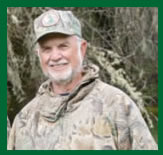Eat 'Em
by Terry Knight
As my father used to tell me when I was a boy, “If you shoot it,
you have to clean it and eat it.”  If you took a poll among duck
hunters, most would say nothing is worse than arriving home
dead tired from a hunt and having to clean a limit of ducks and
geese. That’s why so many ducks end up in the trash can. Even
hunters who want to avoid cleaning the birds by giving them to
friends find few takers. Just visualize taking a pair of unpicked
mallards to your neighbor’s house and plopping them on the table
for her to clean. The Lady of the House’s response is more than
likely to be “we don’t eat ducks.”
If you took a poll among duck
hunters, most would say nothing is worse than arriving home
dead tired from a hunt and having to clean a limit of ducks and
geese. That’s why so many ducks end up in the trash can. Even
hunters who want to avoid cleaning the birds by giving them to
friends find few takers. Just visualize taking a pair of unpicked
mallards to your neighbor’s house and plopping them on the table
for her to clean. The Lady of the House’s response is more than
likely to be “we don’t eat ducks.”
Discarding wildlife is not only unethical, it’s also illegal. It falls under the Department of Fish and Game Code “wanton waste of fish or game” where the fine can be very high.
Every year I receive a number of calls from hunters who ask what is the easiest method of cleaning a duck or goose. As one who has picked literally hundreds of ducks over the past 50 years I find that with a little practice a hunter can pick his ducks as fast as a duck plucking machine. It takes me no longer than five minutes to completely clean a mallard.
A high percentage of duck hunters just “breast out” their birds and then discard the rest of the carcass. A few even skin out the bird, but I prefer to pluck the whole duck.
If possible, ducks should be picked as soon as possible. If the carcass is still warm the feathers will come out easily. But even if you wait until the next day it’s still an easy task to pick a duck.
Place a large garbage bag in an empty trash can to gather the feathers. Hold the bird in your left hand with the breast up. Your left thumb should be pressed tightly down on the upper part of the breast to hold the skin tight. Using your right thumb and forefinger, grab a small bunch of feathers and give a sharp jerk. I like to start near the neck and pick the breast down to the tail feathers. The trick is keep your left thumb near the area where you are picking to keep the skin tight. If you try and remove too many feathers at one time you will break the skin.
Turn the duck over and pick the back. Pull out the tail feathers and cut off the wings tight to the body by forcing the wings upward which will expose the first joint. Cut through the joint with a sharp knife. Finally sever the head tight to the breast. Leave the feet on the duck.
Using a small propane torch, hold the bird upside down by grasping one of the feet and singe the down and small feathers off the carcass. Cut off the feet at the knee joint. Finally make a cut from the bottom of the breast bone to the tail and remove the innards from the bird, making sure the cavity is completely clean of the lungs and all blood clots.
Wash the carcass thoroughly inside and out. Place the bird in a pan and cover it with table salt and fill the pan with cold water. Place in the refrigerator or in a cool area and allow it to sit overnight. The salt will draw out any blood from the carcass. Twenty-four hours later drain the water and thoroughly rinse the bird which removes the salt.
Allow the bird to sit in a cool place for another 24 hours before wrapping and placing it in the freezer. A duck can be frozen for more than a year and still be edible. If you use one the new vacuum pack machines it will last several years.
There are hundreds of recipes on how to cook a wild duck. They range from serving them so raw they’re still quacking to being well done. My favorite method of cooking a duck is to first make a mixture of cinnamon, sugar, nutmeg and a little garlic and then rub it into the carcass. I place the ducks on an electric rotisserie and cook them until a clear liquid comes out when poked in the breast. I slice the breast and remove the legs and serve it with cranberry sauce. Actually the legs of a duck are very tender and tasty.
The biggest complaint that people have about eating wild ducks is that they taste like liver. But, cooked correctly and served with a sauce and a glass of red wine, they can be a gourmet’s delight. W.U. has some of the best duck properties in the state and having the opportunity to not only hunt ducks and geese but also having them for dinner is about as good as it gets.
